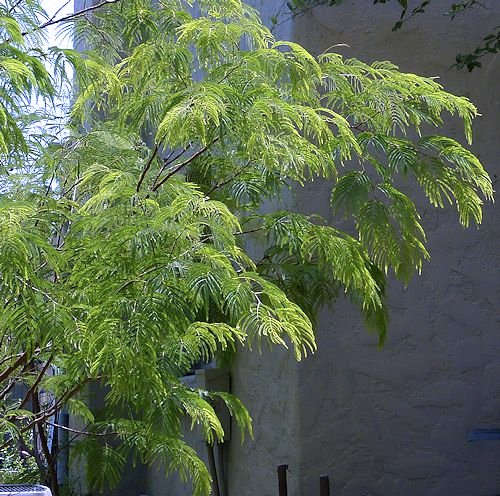Growing Lysiloma watsonii:
Feather Bush
Back to Trees and Palms
Description
Form: A multi-trunked shrub, or with pruning, a tree.
Leaf retention: Semi-evergreen.
Growth rate: Slow to moderate.
Mature Size: 12-15' (3.7-4.5m) high and wide.
Flowers: Creamy white puffballs, 1/2" (12mm) diameter, in terminal clusters.
Bloom: Spring.
Fruit: A flat seed pod, constricted around its seeds, turning dark brown, persisting on the plant until fall.
Leaves: Tiny green leaflets, with a fern-like appearance. The leaflets turn yellow mid-spring, then drop and are quickly replaced before blooming. New leaflets are lime-green. This tree provides light filtered shade.
Stems: The bark becomes gray and fissured with age.
Roots: Nitrogen-fixing*. Both root and stem suckers are produced at the base of its trunk.
Wildlife: The flowers attract butterflies, bees, and wasps. This plant hosts caterpillars of blue and sulphur butterflies. Birds use it for shelter and nesting.
Toxic / Danger: No.
Origin: Arizona and Mexico.
Form: A multi-trunked shrub, or with pruning, a tree.
Leaf retention: Semi-evergreen.
Growth rate: Slow to moderate.
Mature Size: 12-15' (3.7-4.5m) high and wide.
Flowers: Creamy white puffballs, 1/2" (12mm) diameter, in terminal clusters.
Bloom: Spring.
Fruit: A flat seed pod, constricted around its seeds, turning dark brown, persisting on the plant until fall.
Leaves: Tiny green leaflets, with a fern-like appearance. The leaflets turn yellow mid-spring, then drop and are quickly replaced before blooming. New leaflets are lime-green. This tree provides light filtered shade.
Stems: The bark becomes gray and fissured with age.
Roots: Nitrogen-fixing*. Both root and stem suckers are produced at the base of its trunk.
Wildlife: The flowers attract butterflies, bees, and wasps. This plant hosts caterpillars of blue and sulphur butterflies. Birds use it for shelter and nesting.
Toxic / Danger: No.
Origin: Arizona and Mexico.
Cultivation and Uses
USDA hardiness zones: 9b-10 in arid regions. This plant is damaged at
28°F (-2.2°C).
Heat tolerant: Yes.
Drought tolerant: Yes.
Sun: Full sun to part shade.
Soil: Well draining, dry to moist, pH 6.1-9.0 (slightly acidic to highly alkaline). *Do not use a nitrogen fertilizer.
Water after becoming established: Once or twice a month.
Mulch: This plant is self-mulching in the spring. Allow some leaf litter to stay under the tree, but avoid a heavy build-up.
Prune: Remove suckers from the base of the trunk as needed. To shape into a tree, select two or three main stems in winter and remove the rest, then gradually remove the lowest branches over several years in winter. This tree will not conform to a specific shape but can be guided.
Litter: High. Leaves, flowers, and seedpods.
Propagation: Seed, which must be scarified. This tree can reseed itself under favorable conditions.
Uses: Ornamental, low water (xeriscape) garden.
USDA hardiness zones: 9b-10 in arid regions. This plant is damaged at
28°F (-2.2°C).
Heat tolerant: Yes.
Drought tolerant: Yes.
Sun: Full sun to part shade.
Soil: Well draining, dry to moist, pH 6.1-9.0 (slightly acidic to highly alkaline). *Do not use a nitrogen fertilizer.
Water after becoming established: Once or twice a month.
Mulch: This plant is self-mulching in the spring. Allow some leaf litter to stay under the tree, but avoid a heavy build-up.
Prune: Remove suckers from the base of the trunk as needed. To shape into a tree, select two or three main stems in winter and remove the rest, then gradually remove the lowest branches over several years in winter. This tree will not conform to a specific shape but can be guided.
Litter: High. Leaves, flowers, and seedpods.
Propagation: Seed, which must be scarified. This tree can reseed itself under favorable conditions.
Uses: Ornamental, low water (xeriscape) garden.
Comments
This plant is a member of the Legume family (Fabaceae). It will naturally grow into a monster shrub if left on its own.
Do you have additional information or a different experience for these plants that you would like to share? Email info@GardenOracle.com. All contributions are welcome and appreciated.
This plant is a member of the Legume family (Fabaceae). It will naturally grow into a monster shrub if left on its own.
Do you have additional information or a different experience for these plants that you would like to share? Email info@GardenOracle.com. All contributions are welcome and appreciated.





Latest update: September, 2024
© 2008-2025 by GardenOracle.com

